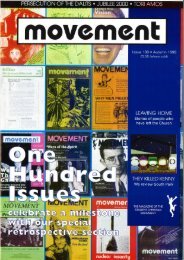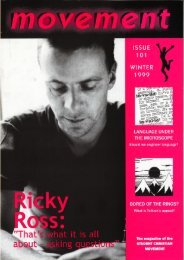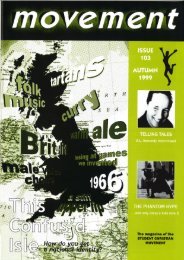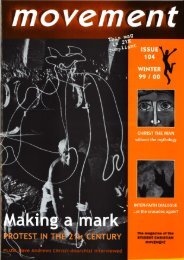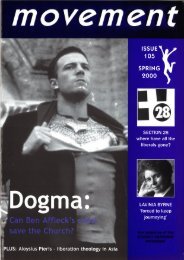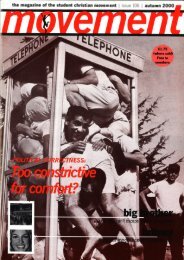Movement Magazine: Issue 162
Issue 162 is here, and for the first time ever we're going completely digital! In this issue we interview Andriaan Van Klinken on finding his identity as an academic and queer Christian, look at how urban gardening could start a revolution, and reflect on Blackness, queerness and the missio dei with Augustine Ihm, plus loads more!
Issue 162 is here, and for the first time ever we're going completely digital! In this issue we interview Andriaan Van Klinken on finding his identity as an academic and queer Christian, look at how urban gardening could start a revolution, and reflect on Blackness, queerness and the missio dei with Augustine Ihm, plus loads more!
Create successful ePaper yourself
Turn your PDF publications into a flip-book with our unique Google optimized e-Paper software.
Students from across the movement entered the ‘Letters for Creation’ project this summer.
Soph, who organised the group, tells us why the project was important to her, and Ellen,
the author of the poem, helps us dive into the metaphors and imagery she used. You can
hear the full poem, read by SCM members, on our Facebook page.
Where the Four
Rivers Meet
An Introduction
In 2017, the Archbishop of Canterbury invited senior clergy
from across the Anglican Communion to share their thoughts
on what caring for God’s creation meant to them. Letters for
Creation is a follow-up project, which invites young people
to reflect on what it means to them to care for the world
around us and how they want their voices to be heard in the
call for climate justice. It’s a creative project that serves as
an opportunity to amplify the voices of young people on the
topic of climate justice. Letters can take a traditional or more
creative form. At SCM, we decided to come together and
make a film of members reading a poem that was written by
one member.
Young people have been at the front line of climate action
in the last few years. In February 2019, thousands of young
people across the UK left their classrooms and took to the
streets to stand up for their futures, chanting: “We need
change and we need it now”. Since then, young people
have been regularly protesting and lobbying politicians. I
believe that young people care so much about climate action
because they are tuned in with God’s call for us to care for
the His Creation. This is the model of faith and action that we
should base our lives on. God’s creation is a gift, one that we
have been tasked with the stewarding of. This provided the
inspiration for the final line in Where the Four Rivers Meet,
“this is our thing to bear”.
Selected letters from the project will be curated into an
exhibition that will be launched digitally later this year,
followed by a travelling exhibition that we hope will tour a
number of UK cathedrals, COP26 (the UN’s climate change
conference), and the Lambeth Conference in 2021. To find
out more about Letters for Creation, check out the web-page.
SOPH MITCHELL
Ideas and Inspirations
Where the Four Rivers Meet is set in Eden and starts with
a tree. Roots are embedded in the earthly soil while the
branches reach up to heaven, a physical link between the
two like Captain America holding back the Winter Soldier’s
helicopter in Captain America: Civil War.
I based Where the Four Rivers Meet on three big ideas which
I hold as part of my personal theology. The first of these was
a function interpretation of the Imago Dei. This is the idea
that humans’ being made in the image of God is not to say
that there is something about humans which images God
in some way (such as intelligence or rationality) but rather
that the image of God is a responsibility given to humans
to care for creation around them. This particularly comes
out in the second stanza, where I specifically reference the
image and how being made in the image makes creation
and its flourishing ‘my thing to bear’.
The second idea is that of a positive relationship between
Christian theology and evolutionary biology. Specifically, I
wanted to reference the long process by which life on Earth
emerged and the ancestry of the species Homo sapiens. I
brought this out in the third stanza, referencing earthly life’s
oceanic origins and that humans are, however distantly,
descended from those first underwater organisms.
The third idea is that of universal redemption – that
everything, human or not, will go to heaven. In stanzas
four and five, I reference earthly (biological) death and a
heavenly life after death. Just as all life on Earth ends up
as dust, so too will all life on Earth share in a heavenly life.
ELLEN LESSER
40 MOVEMENT Issue 162 MOVEMENT Issue 162
41










